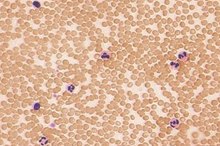Foods That Contain Leptin
Leptin is a hormone produced by the body that affects body weight and metabolism. For individuals trying to lose weight, it is important that leptin levels in the body stay low. Eating foods rich in omega-3 fatty acids such as fish and flax seeds will help lower leptin levels. Additionally, recent research suggests that some obese individuals do not naturally make leptin, which in turn causes their obesity.
Description
Leptin, a hormone produced by the body, affects metabolism, reproductive function and the body's ability to regulate weight. If leptin levels are low, fat metabolism is high. On the other hand, if leptin levels are high, fat metabolism is low.
Leptin and Obesity
How to Reduce Leptin Levels
Learn More
Leptin communicates to the brain that fat is on the body. Individuals whose bodies do not produce leptin are at risk for obesity since the brain thinks there is no fat on the body. This causes the individual to have the desire to eat more. Injections of leptin into the body of these individuals has helped with weight loss 1.
- Leptin communicates to the brain that fat is on the body.
- Individuals whose bodies do not produce leptin are at risk for obesity since the brain thinks there is no fat on the body.
Foods That Decrease Leptin
The body cannot consume leptin--it must produce it.
Research
Fish & Chicken Diet
Learn More
Researchers at the Mayo Clinic studied two African tribes' leptin levels. One tribe ate fish regularly, and the other tribe ate primarily vegetables. The study revealed that the tribe who ate fish had leptin levels that were five times lower, which suggests eating fish is beneficial in lowering leptin levels.
Sample Meals
Not sure how to include fish in your meals? Try making fish tacos made from tuna, halibut or cod with salsa, guacamole, lettuce and tomatoes. Another option is baking fish rubbed with lemon pepper and serving it over rice with a side of asparagus.
Related Articles
References
- Definition of Leptin
- Negative Calorie Foods & Fat-Burning Foods
- Society for Endocrinology: Your and Your Hormones. Leptin. Bristol, United Kingdom: Society for Endocrinology 2020 https://www.yourhormones.info/hormones/leptin
- Myers MG Jr, Leibel RL, Seeley RJ, Schwartz MW. Obesity and Leptin Resistance: Distinguishing Cause from Effect. Trends in Endocrinology and Metabolism. 2010;21(11):643–651. doi:10.1016/j.tem.2010.08.002November 2010
- Vasselli JR, Scarpace PJ, Harris RB, Banks WA. Dietary components in the development of leptin resistance. Adv Nutr. 2013;4(2):164–175. doi:10.3945/an.112.003152
- Myers MG Jr, Heymsfield SB, Haft C, et al. Challenges and opportunities of defining clinical leptin resistance. Cell Metab. 2012;15(2):150–156. doi:10.1016/j.cmet.2012.01.002
- D'souza AM, Neumann UH, Glavas MM, Kieffer TJ. The glucoregulatory actions of leptin. Mol Metab. 2017;6(9):1052–1065. doi:10.1016/j.molmet.2017.04.011
- Refinery29.com. Before Keto, the Leptin Diet Was Huge. By Cory Stieg. May 10, 2019. New York, New York: Refinery 29 Vice Media 2020 https://www.refinery29.com/en-us/what-is-leptin-diet-foods
Writer Bio
Lindsay Nixon has been writing since 2007. Her work has appeared in "Vegetarian Times," "Women's Health Magazine" and online for The Huffington Post. She is also a published author, lawyer and certified personal trainer. Nixon has two Bachelors of Arts in classics and communications from the College of Charleston and a Juris Doctor from the New England School of Law.








